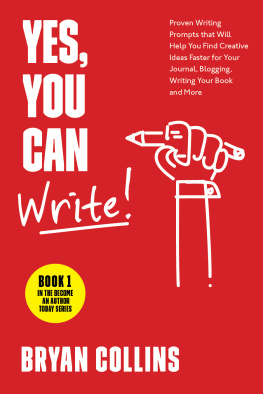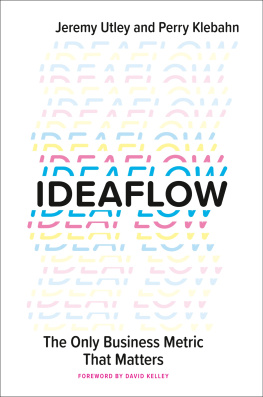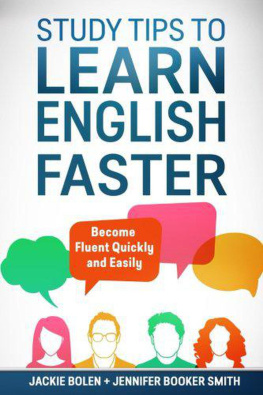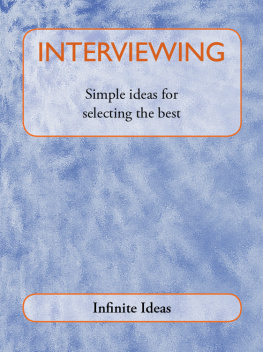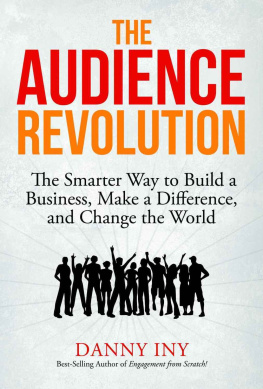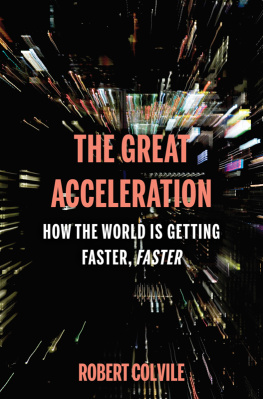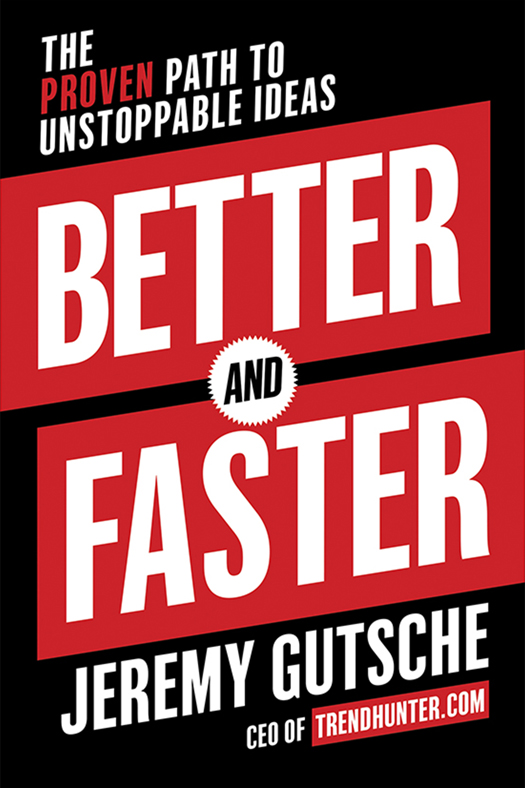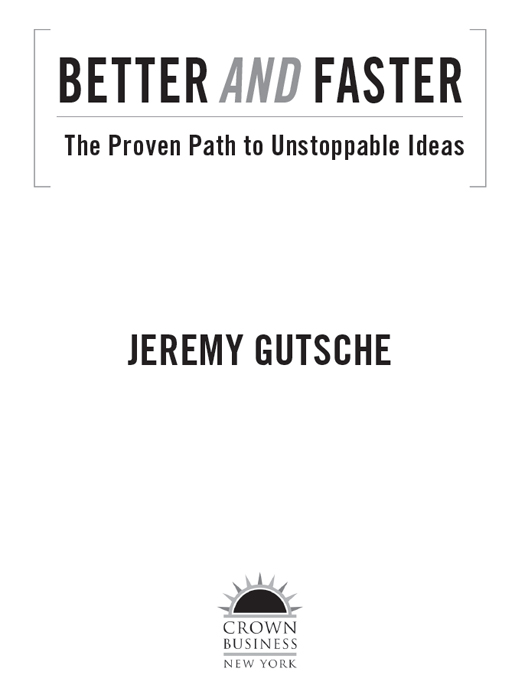Copyright 2015 by Jeremy Gutsche Consulting Inc.
All rights reserved.
Published in the United States by Crown Business, an imprint of the Crown Publishing Group, a division of Random House LLC, a Penguin Random House Company, New York.
www.crownpublishing.com
CROWN BUSINESS is a trademark and CROWN and the Rising Sun colophon are registered trademarks of Random House LLC.
Crown Business books are available at special discounts for bulk purchases for sales promotions or corporate use. Special editions, including personalized covers, excerpts of existing books, or books with corporate logos, can be created in large quantities for special needs. For more information, contact Premium Sales at (212) 572-2232 or e-mail .
Library of Congress Cataloging-in-Publication Data is available upon request.
ISBN 978-0-385-34654-2
eBook ISBN 978-0-385-34655-9
Jacket design by Michael Nagin
v3.1
S HELAGH G UTSCHE:
This book is dedicated to you, my champion of a mother, for everything youve done to raise two happy, motivated, entrepreneurial kids while teaching us the importance of family, friends, and understanding people.
Contents
PROLOGUE
Paper planes, rocket ships, human hearts, and origami. These are seemingly unrelated elements, but not to Robert Lang, an origami expert-for-hire who uses the power of paper-folding to save lives. Many of us have folded a few paper planes in our day, but Lang turned the ancient Asian craft into his lifes passion. His peculiar journey began in the first grade, when his teacher gave him an origami art book. She hoped the quirky challenge would keep him from distracting his peers. She was right. Lang became obsessed over his newfound folding hobby.
Origami may be fun, but many will see the pursuit as frivolous. What Langs teachers didnt realize was that with each paper plane pleated and each origami crane crafted, Lang came closer to unlocking secrets that would transform him into a leading innovator in aerospace, heart surgery, and automotive engineering. What did Lang see that others didnt? He started seeing more than just the art.
He saw the patterns.
Patterns surround us. We eat them, see them, smell them, taste them, and walk past them every day. But most people fail to connect the dots. They dont recognize ideas that others will relate to, gaps in service, or niches where one can rake in profits simply by diverging from the mainstream.
For Lang, the patterns were inescapable, especially when he delved deeper into the art of paper folding, a traditional hobby that had been stagnant for centuries and seemingly limited in scope. Certain shapes were considered too difficult to re-create, such as spiders, bugs, or beetles. But those limits only challenged Langs imagination. He was enthralled by impossibilities. He didnt know it at the time, but this was his awakening.
By day, Lang studied electrical engineering at Stanford and eventually earned a PhD at Caltech, writing his thesis on Semiconductor Lasers: New Geometries and Spectral Properties. His doctoral work was unrelated to his art, but away from his academic pursuits, he studied the Japanese origami greats and taught himself to fold excruciatingly difficult constructions, including a paper Jimmy Carter and Darth Vader. He wanted to fold fire ants, hermit crabs, and dragons, but these feats remained beyond his grasp.
Origami was an all-consuming hobby.
Post-PhD, Lang became a talented fiber-optic researcher, but during his off-hours, he fed his hunger for origami, joining the competitive underworld of Japanese origami. His accomplishments earned him acceptance into the Origami Detectives, a Japanese-based alliance of paper-folders who dared to dream of unthinkably intricate folding feats, such as creating a horned winged beetle.
Work and play soon merged. Laboring with the intensity of a mad scientist, Lang began to see the science behind his origami. He discovered that all shapes follow a few predictable patterns, a truth that had been overlooked for centuries. And he developed a software program to calculate the folding pattern of almost any figure imaginable: He would input a simple stick drawing into the program, and the software would spell out the folds needed to craft what was previously thought to be impossible. His fellow paper-folders called it The Secret Weapon.
Lang revolutionized origami. Finally, he was able to fold the coveted winged spotted beetle. Suddenly, the degree of difficulty in origami competitions skyrocketed, with the average number of folds per paper tripling from thirty to a hundred.
Despite having secured forty-six patents in optoelectronics, at He dedicated his life to hunting unexplored origami opportunities. There were plenty of people doing lasers, he said. The things I could do in origamiif I didnt do them, they wouldnt get done.
Lang was right, but there was a hidden meaning in his message. He realized that origami could help a world desperate for solutions. Langs breakthroughs demonstrated how creative folding techniques can solve a range of mechanical engineering problems. When NASA needed a revolutionary way to fold a telescope into a rocket ship, they availed themselves of Langs expertise. When a German automaker needed a superior technique to pack air bags, Langs origami came to the rescue. Today, bioengineers even use his origami approach to pack strands of DNA.
Almost all innovation happens by making connections between fields that other people dont realize, Lang explained to me. To find opportunity, he said, one should Look for connections and try to understand the patterns. Its all well and good to see a connection between two fields, but if you understand the underlying pattern, then you can more easily see similar types of connections at play in other fields of endeavor.
Langs seemingly miraculous ability to expand origami beyond its original roots is an apt metaphor for this book. Lang teaches us that somewhere out there, your big idea probably exists. You just need to know where to look. By learning to find patterns in all sorts of unusual places, you can benefit from advances in other industries, accelerate your search for new ideas, and better realize your potential.
But theres a catch. Pattern awareness is not as easy as it might first seem. In the 1950s, the average life span of a Fortune 500 company was seventy-five years, similar to that of a human. Today, the Companies are failing to adapt. In the last decade, Kodak, Borders, Trump Entertainment, Hostess Foods, and Tower Records have all collapsed, not to mention all the U.S. airlines, banks, and automakers that had to be rescued by multibillion-dollar government bailouts. Its clear that we need to be better at spotting the destructive patterns that regularly roll over us like a tidal wavebut we also need to be better at tucking into the curl of that wave and riding it for all its worth.
After years of advising hundreds of top brands, ranging from Coca-Cola to IBM to Victorias Secret, Ive learned that the only thing more powerful than an idea is the culture that nourishes itor that prevents it from taking root. Part of what this book offers is a way to overcome the psychological and cultural traps that cause smart people to overlook opportunity.
THE POWER OF THE CROWD


